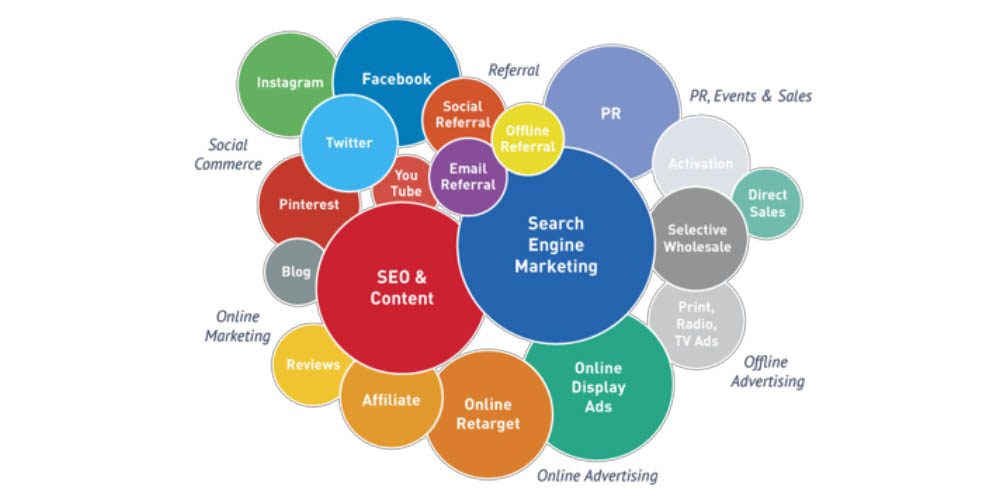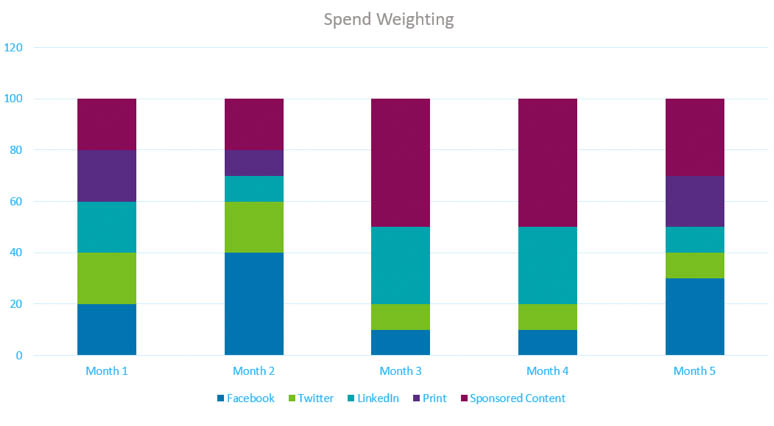Put simply, multi-channel marketing utilisers a strategy that has numerous touch/entry points to your content/message/product. Beyond just a single e-blast, or magazine advert operating in isolation. It takes way more than just a single point of interaction to convert a modern day buyer. Multiple channels are now responsible for generating a single conversion. This guide gets you through the basics.
- What is multi-channel marketing and what do those channels look like
- Best practise and spend weighting of channels – where to put your budget
- Continual optimization by channel – campaigns don’t start once you press go
- Working with your audience
What channels are available
How long is a piece of string. More importantly though, ask yourself what combination of channels will get your target audience to convert. How many times do you need to interact with them, and how far do you build out that journey. Of course, the longer the journey, the more likely it is your CPA (cost per action/conversion) will be higher.

Working with channels during your planning stage
- Working out and planning your channels should be an equal priority to planning your content.
- Different people want to consume different content in different ways.
So for example: an email and a Facebook ad may point to two different pieces of content, or the same piece but reworked – in order to give the best experience. If using social, your audience will likely be more mobile heavy, so perhaps your content would work with a bigger image focus and perhaps fewer words…?
- Use your channels in conjunction with each other
- Create a re-marketing strategy that develops audiences, and follows on your message onto a second, third and fourth stage of marketing
- Map it out! Draw out a flow of where your contacts are coming from.
Making the most of remarketing
Remarketing is actually super cool. Imagine being able to send a communication to someone who visited your website, even if they forget to subscribe to your newsletter. There is a common misconception among marketers that without an email, or a postal address, the first interaction is pointless and has not succeeded.
Remarketing pixels on social channels and in Google, allow us to track a contact even after they have left. You basically now know who this person is. Just because you don’t have an email address for them (to send lots of spamming email marketing messages to them) you can still get your brand in front of them.
Think of remarketing audiences simply as email lists – only better. In the map that you build when planning, work out how these lists will be formed.
For example:
Visited Content 1: Add to List 1
—- Use list one to market on Facebook content 2
Visited Content 1 AND 2: Add to list ‘Time for hard sell’
—-Use ‘Time for hard sell’ list to market with direct sign-up messaging.
A very rough idea of how you can use remarketing – but consider your lists and rules as segments not just empty buckets of data.
It Takes 6 to 8 Touches to Generate a Viable
Sales Lead.
(Salesforce)
Give something for free, vary your call to actions, push different content in different places. Don’t chase an email address!

The above shows a journey from a blog to a webinar. Before getting a contact to register for the webinar, we’ve exposed them to two pieces of content, without even knowing who they are. This could go further – there could be four or five different touches before you put a conversion option in front o them (i.e a sign-up or demo or buying form). It demonstrates that in some cases, winning brand trust and getting familiarity through giving something away for free is way more valuable than a simple gate or conversion form. Our theory here is that your conversion rate on your form after this journey will be higher, and ultimately your CPA will be lower.
Spend weighting by channel
You may not want to start off with equal spend weighting across your channels. Some channels may be stronger in some countries than others – for example (i.e Pinterest is much more widely used in the US than in the UK). Or, perhaps LinkedIn is more relevant to your product than Facebook. However you weight it, when you start your campaign, try and cover multiple channels with a budget. You need to test the water and see what works.
As you move forward, you can asses these channels by whatever metric you wish to use. CTR (Click Through Rate), CPC (Cost Per Click) maybe. We use CPA primarily (Cost Per Action) – an action being a conversation, a form-fill or a purchase. On a very black and white level, you can turn down or turn up your spend purely based on a consistent metric, to optimise and hone in your campaigns.

Assign a value to your interactions
Often when it comes to budgeting and reporting it can be useful to assign a value, or just a number to your inbound activity. This can be done as an excel formula to help you decide how to optimise your budgets. For example:
- One page interaction: 10 points
- Two page interactions: 30 points
- Email Click: 15 points
- New contact: 100 points
You can then add these up by a channel to understand the value of a specific channel. Note that something like generating a new contact could be considered much more valuable than 5 page views from an existing contact.
Report & Optimize by Channel
Take a look at the graph below and see if you can work out what’s going on.

Observations
- While GDN (Google Display Network) is providing the highest number of leads, search provides the highest click-through-rate (CTR) to ‘new lead ratio’. This may suggest that the search budget should be increased.
- Whilst GDN is providing a decent number of leads, the ratio between leads and new contacts suggests there is lots of interaction from existing customers. Is this what is trying to achieve from a paid for channel? Maybe it is, maybe it isn’t!
Expand your audience
Is the decision maker you’re targeting actually the person who comes up with the idea in the first place? For example, Bob at company X signs most things off, but it is his reports and their reports who bring on-board new tool ideas, processes, suppliers etc. There is a concept now emerging of ‘buying groups’ as opposed to ‘personas’. This strategy looks at the range of people involved in making a purchase for B2B marketing, and looking at how to market them all at every level they are responsible for.
This crosses over though into B2C. Perhaps you are marketing to undergraduate students. Marketing to their parents as well could also help support your conversion. ‘Life at CityTown University is all about partying’ V ‘Life at CityTown University is Safe’.
Consider targeting lower than the decision maker level.
jonny
Jonny leads digital performance at Sticky Click, as well as overseeing all performance based creative. He has over a decade of experience working on everything from design for print through to global digital growth campaigns. He's your technical guru at Sticky Click, and a tracking and attribution geek.

